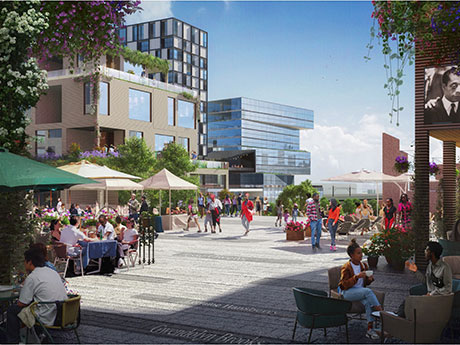By J. Byron Brazier
Equitable development is a knotty concept. In theory, development equity sounds easy and essential. In practice, it’s not clearly defined and not easily sustainable — economically, socially or politically.
Equitable development is generally seen as an approach that revitalizes and empowers disinvested communities by meeting residents’ wants and needs, diminishing disparities and spurring economic growth, ensuring residents benefit from such growth and creating conditions for people to live healthy and happy lives. That definition is accurate but incomplete. Equitable development has multiple meanings, some less intuitive than others.

Chicago lawyer Danielle Meltzer Cassel says there are three ways to define development equity.
The first is the one above, which is the direct model of equitable development. This model rectifies inequality through what development directly produces, such as affordable housing in areas where there’s little or no such housing, good jobs for people who are unemployed or underemployed, greater access to quality healthcare and education, and other resources that allow communities to thrive.
There are two other definitions, the indirect model and what Cassel calls the procedural model of equitable development. The indirect model involves real estate developments that do not directly benefit disinvested communities, such as a downtown luxury building or restaurant, but do create short-term construction jobs, long-term employment opportunities and increased tax revenues.
The procedural model of equitable development brings stakeholders access to legal services and deregulates how land use is entitled. Legal assistance allows people with modest means or limited amounts of land to capitalize on what they have to build financial equity and move up economic ladders, sustaining both direct and indirect development.
Barriers that impede equitable development
The obvious hurdles to equitable development are access to capital and draconian zoning laws. Particularly for the direct model of equitable development, financing is a challenge. As detailed in an April report from the Urban Land Institute, developers pursuing equitable development encounter unfair valuations and appraisals, lenders who deny loans based on perceived risks associated with disinvested communities, and implicit or explicit racism.
Developers of color face stacked odds. A recent report by the Initiative for a Competitive Inner City and the Grove Impact consulting group found that Black and Hispanic developers together make up less than 1 percent of real estate development, and that market access restrains their growth. As for indirect equitable development, the biggest roadblocks are complicated regulatory controls and an underappreciation of indirect benefits.
A significant procedural barrier is an unwillingness on the part of communities and governments to relinquish control over how land is used. Strict zoning laws worsen inequalities, particularly ordinances that prevent the construction of more affordable housing. And because many school systems are based on geography, this often keeps families with fewer means from accessing schools with more resources. There are woefully few legal resources available to navigate land use.
Exclusionary zoning laws promote segregation. A look at the 1926 legal precedent at the heart of zoning encapsulates this point. In Village of Euclid v. Ambler Realty Co., the Supreme Court ruled that local governments have the right to design and impose zoning ordinances. The 6-3 opinion written by Justice George Sutherland referred to apartment buildings as “a mere parasite” and a threat to single-family homes. The proliferation of apartments could, the court wrote, leave a community of detached homes “utterly destroyed.” Such language allows for the dignity and comfort only of people who can afford to live in single-family homes, denigrating and dismissing those who cannot.
Four key elements for creating equitable communities
While the road to effective equitable development can be fraught, the key elements below bolster the likelihood of success:
Deep community engagement: This is not optional; it’s essential. Developers must evaluate what a community wants and needs in the immediate and distant future. They must strive to understand community concerns and take pains to address those concerns without killing the viability of the project. It is a difficult but crucial balancing act.
Understanding from community stakeholders: Developers are responsible for meeting community needs. Ideally, residents are willing to assess the potential benefits of developments, even if they may be indirect, and to acknowledge that no one development can solve entrenched systemic issues.
An example: In Chicago’s Pilsen neighborhood, a six-acre area has been vacant for years. Development plans stalled in debates about gentrification. But since the land is vacant, no residents would be displaced by any type of development. A new plan has been formulated to develop the land, but such long-vacant parcels represent wasted opportunities for construction jobs and lost tax dollars.
In contrast, in Chicago’s Woodlawn neighborhood, residents and other community stakeholders have welcomed development, partnering with Woodlawn Central, a mixed-use, mixed-income project that will turn eight acres of underutilized parking around a longstanding community church into housing, retail, office space and other amenities.
Experienced, dependable industry advisors: Financing, zoning approvals, design reviews, construction requirements — the processes and procedures involved in development are varied and tedious. Developers must assemble a team of knowledgeable, savvy professionals who can navigate this labyrinth conscientiously, sidestepping potential pitfalls and harnessing available resources.
Comprehensive environmental assessments: Developers should consider land from all angles, including environmental risks and cultural markers. Many Black and brown neighborhoods have a history of industrial use with lingering health dangers.
A 2017 report from the NAACP and the Clean Air Task Force found that Black Americans are 75 percent more likely than other Americans to live in fence-line communities, neighborhoods adjacent to facilities that produce harmful waste. Developments in such areas must dedicate funds and focus to environmental remediation and sustainability.
Amenities such as parks and public art play a restorative role in countering this corrosive legacy. Developers should incorporate existing local assets, taking inspiration from the community’s cultural legacy to craft vibrant public spaces.
Like any worthwhile venture, equitable development requires deep commitment, rigorous effort and attention to detail. When handled with care and executed effectively, it is a powerful tool to promote equity and help unravel decades of disparities.
J. Byron Brazier is the lead developer of Woodlawn Central. This article originally appeared in the December 2023 issue of Heartland Real Estate Business magazine.


